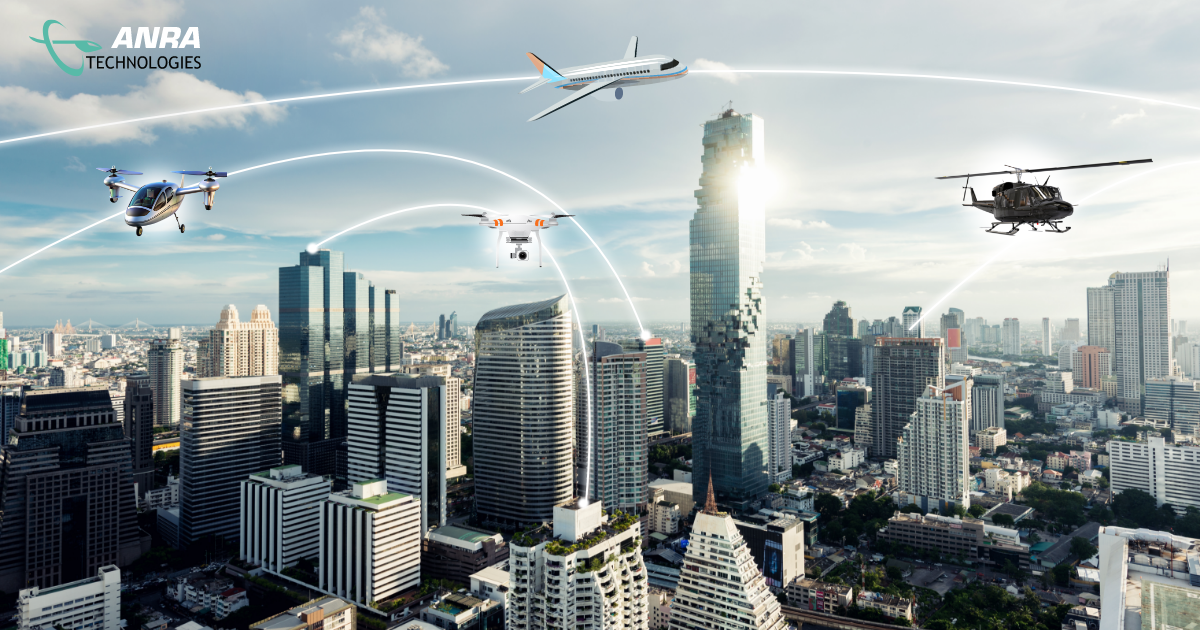The Future of Digital Airspace Management – Avoiding the Next Mishap
On a chilly evening in Washington, D.C., an American Airlines flight and a military helicopter found themselves in a situation that should never happen in modern aviation—a mid-air collision at Ronald Reagan Washington National Airport (DCA) that sent shockwaves through the aviation community. While investigations will uncover the details of what went wrong, the event serves as a stark reminder that despite the layers of safety built into our airspace, gaps still exist. As we integrate more diverse aircraft, including drones and electric vertical takeoff and landing (eVTOL) or powered lift vehicles, these gaps will only widen unless we rethink how we manage our increasingly complex and dynamic skies.
At ANRA Technologies, we have long championed the need for a digital-first approach to airspace management. The future of aviation is not just about electric or uncrewed aircraft—it’s about smarter airspace. The convergence of crewed and uncrewed aviation, military and civilian operations, urban and regional air mobility, and even space launch activities demands an overhaul of traditional air traffic management (ATM) systems. The recent mishap at DCA is a sad reminder for what could happen at a much greater scale if we don’t modernize our approach.
The Challenge – A Fragmented Airspace
Today’s airspace management relies on a patchwork of systems that were never designed for the level of complexity we are now facing. Military and civilian aviation have largely operated in separate spheres, with air traffic controllers acting as the glue that holds it all together. Meanwhile, drone operations and emerging urban air mobility systems often rely on entirely different regulatory frameworks and digital ecosystems.
With the increasing number of aircraft—from passenger jets to autonomous drones and next-generation eVTOLs—there is a pressing need for seamless, real-time coordination across all these domains. The current approach, which leans heavily on human intervention and legacy communication, navigation, and surveillance systems, are struggling to keep up.
The Solution – A Digital, Interoperable Airspace
The answer lies in building an airspace that is dynamic, data-driven, interoperable, resilient, and powered by automation. Digital airspace management, underpinned by real-time data exchange that is enhanced with AI-driven decision-making, is the only way to ensure the safe and efficient coexistence of all airspace users.
- Unified Traffic Management (UTM) and ATM Integration. The future will require seamless integration between traditional air traffic control (ATC) and digital UTM systems. Solutions like ANRA’s Mission Manager and U-Space platform are already proving how data-sharing between these domains can enhance safety and efficiency.
- Predictive Conflict Detection and Avoidance. The recent DCA mishap highlights the need for better deconfliction technology. AI-driven enhanced systems can analyze flight paths, detect potential conflicts, and dynamically reroute aircraft before human controllers even become aware of an issue.
- Automated Airspace Coordination. Real-time, automated flight authorization and coordination between commercial airlines, military operations, and uncrewed aircraft can eliminate misunderstandings and unexpected incursions.
- Cross-Sector Collaboration. No single entity can solve this alone. Governments, regulators, technology providers, and operators must work together to create a shared framework that ensures interoperability between different airspace users.
- Resilient. Digital air traffic management must be resilient, secure, and safe to ensure uninterrupted operations, protect sensitive data, and maintain the highest standards. Robust systems and protocols are essential to counter evolving threats and adapt to dynamic airspace environments
Turning Lessons Into Action
Instead of just reacting to incidents, we must proactively build a safer, smarter airspace. At ANRA Technologies, we are actively working with international regulators, Air Navigation Service Providers, and industry leaders to shape the next generation of airspace management.
Through our involvement in initiatives like the U.S. UTM Implementation (aka the Texas Key Site), European U-Space certification, European Union Aviation Safety Agency (EASA) Rulemaking Group, FAA’s Research, Engineering, and Development Advisory Committee, and digital integration trials in UK and Canada, we are proving that a new approach is not just possible—it’s already happening. These projects demonstrate that digital airspace management can deliver the safety, scalability, and efficiency needed for the future of aviation.
The Path Forward
Aviation is at an inflection point. The mix of new and traditional airspace users will only grow, and relying on decades-old methods and technologies is no longer sustainable. We must embrace digital transformation now to prevent the next catastrophe.
It’s time for regulators, industry stakeholders, and technology providers to accelerate the adoption of modern airspace management solutions. The technology exists. The need is urgent. The only question is whether we act now or wait for a more tragic wake-up call.
At ANRA Technologies, we’re committed to being part of the solution. The future of airspace is digital—let’s build it together.







